HR Management: Cavendish Hotel Performance Analysis and HPWS
VerifiedAdded on 2023/01/12
|10
|3181
|27
Case Study
AI Summary
This case study examines the performance issues at the Cavendish Hotel, a four-star hotel facing negative reviews and employee disengagement. The analysis identifies key causes of poor performance, including limited employee motivation, lack of training and development, and communication/leadership problems. The report then explores the concept and key components of a High Performance Work System (HPWS) specifically tailored for the hotel sector, focusing on ability-increasing, motivation-increasing, and opportunity-increasing HR practices. The recommended HPWS includes improvements in workflow, training, leadership styles, employee participation, technology implementation, and incentive programs. Finally, the study addresses potential barriers to the successful implementation of the proposed system, offering a comprehensive approach to improving the hotel's performance. The analysis is supported by relevant academic literature and presented as a management report.
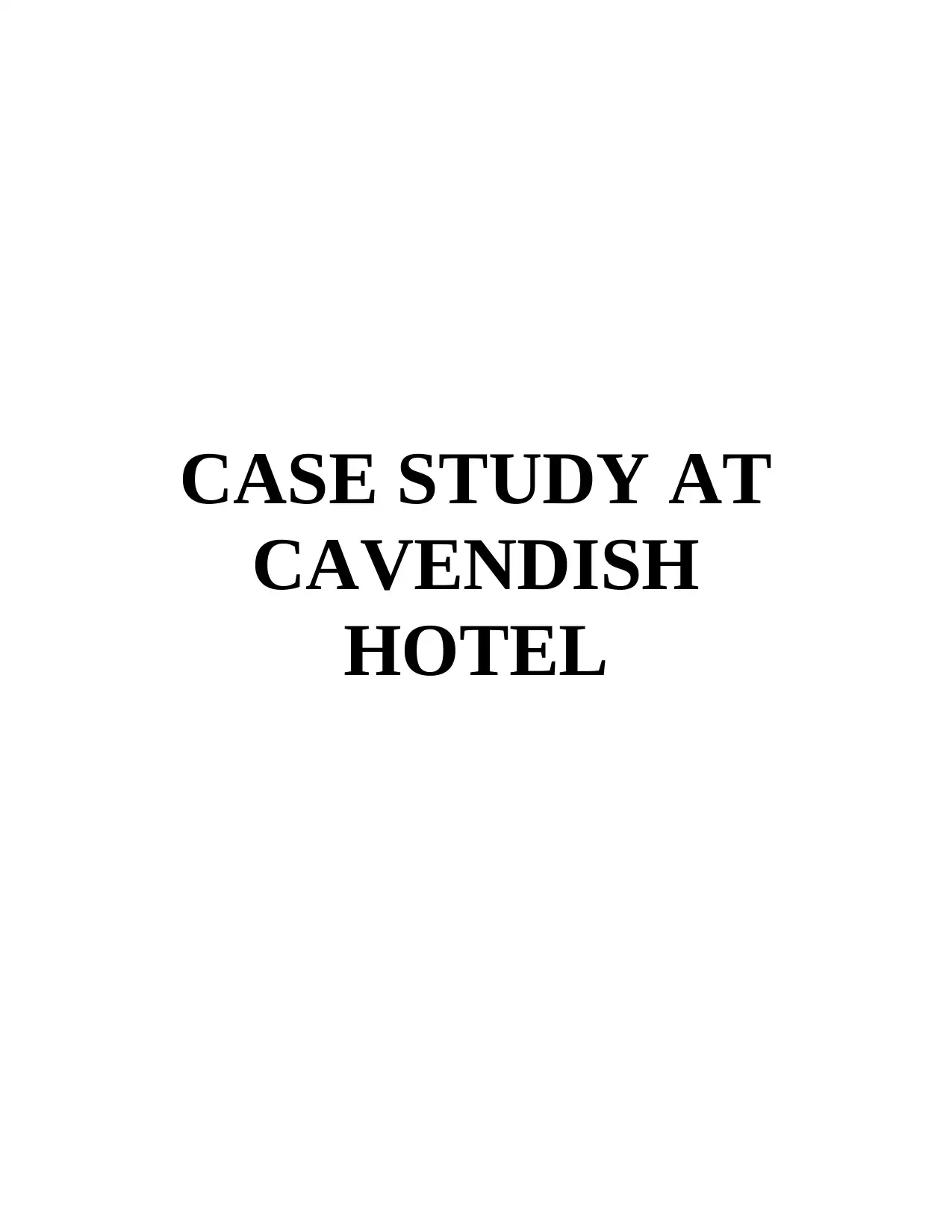
CASE STUDY AT
CAVENDISH
HOTEL
CAVENDISH
HOTEL
Paraphrase This Document
Need a fresh take? Get an instant paraphrase of this document with our AI Paraphraser

Table of Contents
INTRODUCTION...........................................................................................................................1
TASK 1............................................................................................................................................1
Possible Causes of Poor Performance of Cavendish Hotel....................................................1
TASK 2............................................................................................................................................4
Concept and Key Components of HPWS with Specific Reference to Hotel Sector.............4
TASK 3............................................................................................................................................6
Possible Barriers to Successful Implementation of Recommended System..........................6
CONCLUSION................................................................................................................................7
REFERENCES................................................................................................................................8
INTRODUCTION...........................................................................................................................1
TASK 1............................................................................................................................................1
Possible Causes of Poor Performance of Cavendish Hotel....................................................1
TASK 2............................................................................................................................................4
Concept and Key Components of HPWS with Specific Reference to Hotel Sector.............4
TASK 3............................................................................................................................................6
Possible Barriers to Successful Implementation of Recommended System..........................6
CONCLUSION................................................................................................................................7
REFERENCES................................................................................................................................8
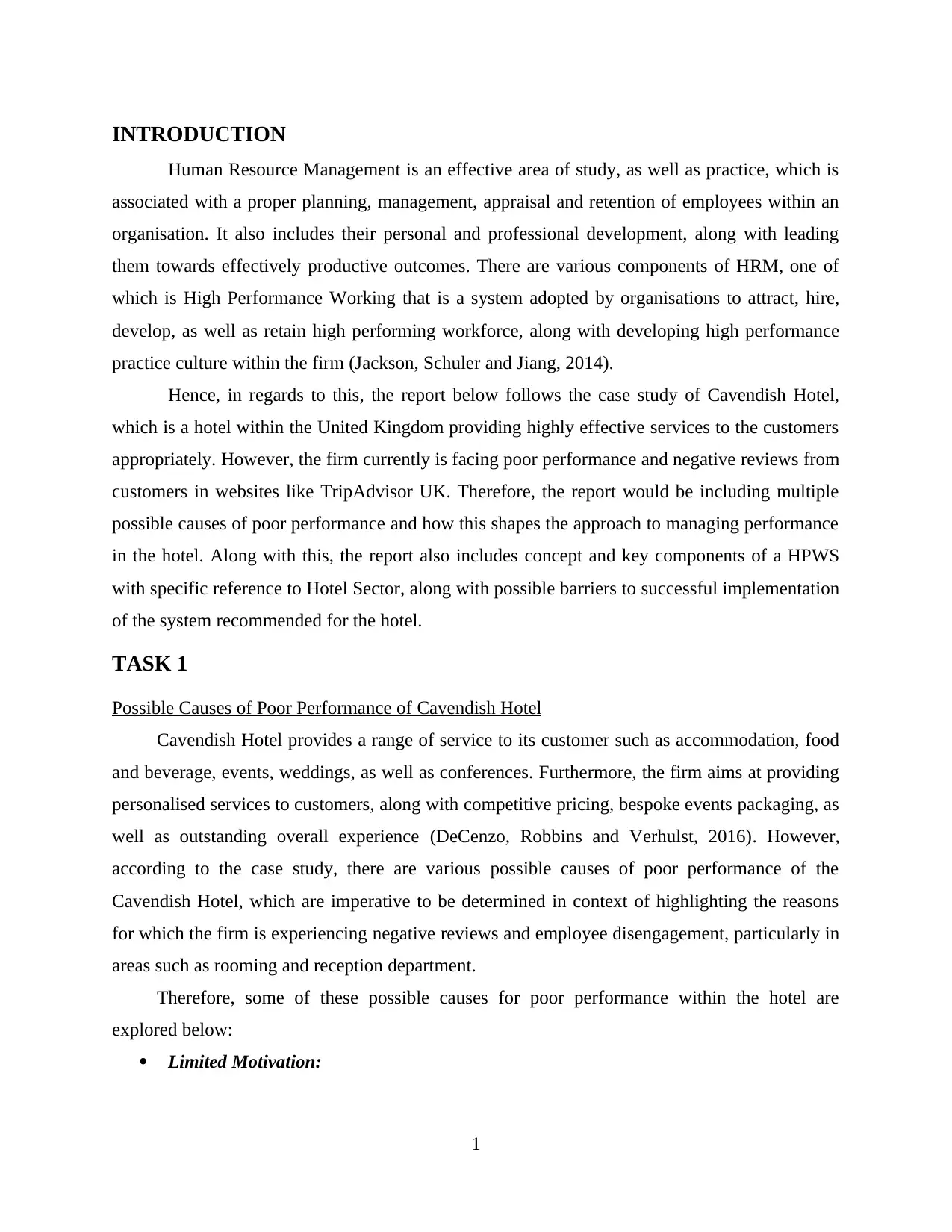
INTRODUCTION
Human Resource Management is an effective area of study, as well as practice, which is
associated with a proper planning, management, appraisal and retention of employees within an
organisation. It also includes their personal and professional development, along with leading
them towards effectively productive outcomes. There are various components of HRM, one of
which is High Performance Working that is a system adopted by organisations to attract, hire,
develop, as well as retain high performing workforce, along with developing high performance
practice culture within the firm (Jackson, Schuler and Jiang, 2014).
Hence, in regards to this, the report below follows the case study of Cavendish Hotel,
which is a hotel within the United Kingdom providing highly effective services to the customers
appropriately. However, the firm currently is facing poor performance and negative reviews from
customers in websites like TripAdvisor UK. Therefore, the report would be including multiple
possible causes of poor performance and how this shapes the approach to managing performance
in the hotel. Along with this, the report also includes concept and key components of a HPWS
with specific reference to Hotel Sector, along with possible barriers to successful implementation
of the system recommended for the hotel.
TASK 1
Possible Causes of Poor Performance of Cavendish Hotel
Cavendish Hotel provides a range of service to its customer such as accommodation, food
and beverage, events, weddings, as well as conferences. Furthermore, the firm aims at providing
personalised services to customers, along with competitive pricing, bespoke events packaging, as
well as outstanding overall experience (DeCenzo, Robbins and Verhulst, 2016). However,
according to the case study, there are various possible causes of poor performance of the
Cavendish Hotel, which are imperative to be determined in context of highlighting the reasons
for which the firm is experiencing negative reviews and employee disengagement, particularly in
areas such as rooming and reception department.
Therefore, some of these possible causes for poor performance within the hotel are
explored below:
Limited Motivation:
1
Human Resource Management is an effective area of study, as well as practice, which is
associated with a proper planning, management, appraisal and retention of employees within an
organisation. It also includes their personal and professional development, along with leading
them towards effectively productive outcomes. There are various components of HRM, one of
which is High Performance Working that is a system adopted by organisations to attract, hire,
develop, as well as retain high performing workforce, along with developing high performance
practice culture within the firm (Jackson, Schuler and Jiang, 2014).
Hence, in regards to this, the report below follows the case study of Cavendish Hotel,
which is a hotel within the United Kingdom providing highly effective services to the customers
appropriately. However, the firm currently is facing poor performance and negative reviews from
customers in websites like TripAdvisor UK. Therefore, the report would be including multiple
possible causes of poor performance and how this shapes the approach to managing performance
in the hotel. Along with this, the report also includes concept and key components of a HPWS
with specific reference to Hotel Sector, along with possible barriers to successful implementation
of the system recommended for the hotel.
TASK 1
Possible Causes of Poor Performance of Cavendish Hotel
Cavendish Hotel provides a range of service to its customer such as accommodation, food
and beverage, events, weddings, as well as conferences. Furthermore, the firm aims at providing
personalised services to customers, along with competitive pricing, bespoke events packaging, as
well as outstanding overall experience (DeCenzo, Robbins and Verhulst, 2016). However,
according to the case study, there are various possible causes of poor performance of the
Cavendish Hotel, which are imperative to be determined in context of highlighting the reasons
for which the firm is experiencing negative reviews and employee disengagement, particularly in
areas such as rooming and reception department.
Therefore, some of these possible causes for poor performance within the hotel are
explored below:
Limited Motivation:
1
⊘ This is a preview!⊘
Do you want full access?
Subscribe today to unlock all pages.

Trusted by 1+ million students worldwide

One of the most crucial reasons that is to be considered in light of poor performance of the
organisation is that there are limited motivations given to the employees to perform better. To
support this claim, it is first necessary to analyse and critically evaluate the annual appraisal
system which the company has adopted (Bailey and et. al., 2018). The scheme which is followed
by the organisation is related to Individual Performance Related Pay (IPRP), within which the
firm offers at least 1 percent minimum increase to each employee annually and then it
categorises all the employees in terms of various rankings, which then sets up the basis of further
review of their appraisals individually.
However, there are certain flaws within this system upon which the firm is heavily relying
upon. For example, Cavendish Hotel operates within Service sector, which has high rate of
dynamism and various tasks which are quite difficult and sometimes impossible to be measured
in quantifiable terms. Therefore, this system might be inaccurate in judging the actual
performance levels and rates of increase in their salaries. Therefore, it depends upon the
perception of employees that whether that person would be motivated or not.
Another element which is associated with lack of motivation and poor performance is that the
appraisal system offers a percent increase within salaries of each individual annually irrespective
of their performances. However, this plays a psychological glitch towards employees, providing
them satisfaction of assured increment in salaries, which somehow does not motivate them to
work harder and therefore, leads to poor performance (Bratton and Gold, 2017). Absence of Training and Development:
Another reason as to why the hotel’s performance is poor is associated with the fact that the
company does not pay enough and necessary attention towards training and development. It is
decided after the interim performance appraisal review that whether the employees need training
or not. Hence, with regular skills and limited access to training, employees tend to perform
below expectations. Moreover, the case study does not mention any sort of rotation, shifts,
transfers or changes, which makes it even more difficult for the employees to give their best
performances within such a dynamic environment.
Moreover, the major problems of this regard has been witnessed within the Rooming and
Reception Department, which has lack of necessary resources, appropriate guidance, as well as
effective training that is imperative for better attending of rooms and customers. Moreover, this
also could be reflected by the reviews which people are giving the organisation on TripAdvisor
2
organisation is that there are limited motivations given to the employees to perform better. To
support this claim, it is first necessary to analyse and critically evaluate the annual appraisal
system which the company has adopted (Bailey and et. al., 2018). The scheme which is followed
by the organisation is related to Individual Performance Related Pay (IPRP), within which the
firm offers at least 1 percent minimum increase to each employee annually and then it
categorises all the employees in terms of various rankings, which then sets up the basis of further
review of their appraisals individually.
However, there are certain flaws within this system upon which the firm is heavily relying
upon. For example, Cavendish Hotel operates within Service sector, which has high rate of
dynamism and various tasks which are quite difficult and sometimes impossible to be measured
in quantifiable terms. Therefore, this system might be inaccurate in judging the actual
performance levels and rates of increase in their salaries. Therefore, it depends upon the
perception of employees that whether that person would be motivated or not.
Another element which is associated with lack of motivation and poor performance is that the
appraisal system offers a percent increase within salaries of each individual annually irrespective
of their performances. However, this plays a psychological glitch towards employees, providing
them satisfaction of assured increment in salaries, which somehow does not motivate them to
work harder and therefore, leads to poor performance (Bratton and Gold, 2017). Absence of Training and Development:
Another reason as to why the hotel’s performance is poor is associated with the fact that the
company does not pay enough and necessary attention towards training and development. It is
decided after the interim performance appraisal review that whether the employees need training
or not. Hence, with regular skills and limited access to training, employees tend to perform
below expectations. Moreover, the case study does not mention any sort of rotation, shifts,
transfers or changes, which makes it even more difficult for the employees to give their best
performances within such a dynamic environment.
Moreover, the major problems of this regard has been witnessed within the Rooming and
Reception Department, which has lack of necessary resources, appropriate guidance, as well as
effective training that is imperative for better attending of rooms and customers. Moreover, this
also could be reflected by the reviews which people are giving the organisation on TripAdvisor
2
Paraphrase This Document
Need a fresh take? Get an instant paraphrase of this document with our AI Paraphraser
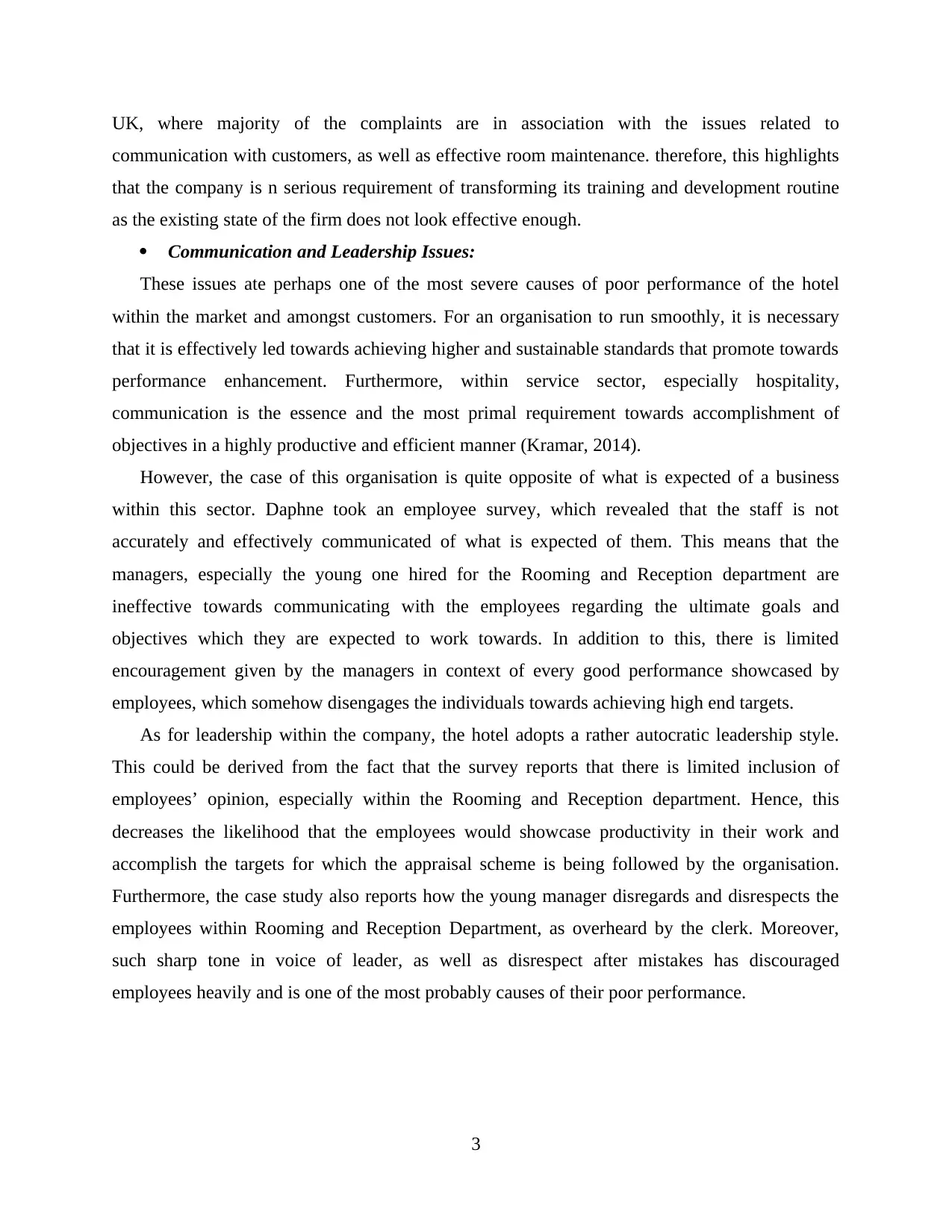
UK, where majority of the complaints are in association with the issues related to
communication with customers, as well as effective room maintenance. therefore, this highlights
that the company is n serious requirement of transforming its training and development routine
as the existing state of the firm does not look effective enough.
Communication and Leadership Issues:
These issues ate perhaps one of the most severe causes of poor performance of the hotel
within the market and amongst customers. For an organisation to run smoothly, it is necessary
that it is effectively led towards achieving higher and sustainable standards that promote towards
performance enhancement. Furthermore, within service sector, especially hospitality,
communication is the essence and the most primal requirement towards accomplishment of
objectives in a highly productive and efficient manner (Kramar, 2014).
However, the case of this organisation is quite opposite of what is expected of a business
within this sector. Daphne took an employee survey, which revealed that the staff is not
accurately and effectively communicated of what is expected of them. This means that the
managers, especially the young one hired for the Rooming and Reception department are
ineffective towards communicating with the employees regarding the ultimate goals and
objectives which they are expected to work towards. In addition to this, there is limited
encouragement given by the managers in context of every good performance showcased by
employees, which somehow disengages the individuals towards achieving high end targets.
As for leadership within the company, the hotel adopts a rather autocratic leadership style.
This could be derived from the fact that the survey reports that there is limited inclusion of
employees’ opinion, especially within the Rooming and Reception department. Hence, this
decreases the likelihood that the employees would showcase productivity in their work and
accomplish the targets for which the appraisal scheme is being followed by the organisation.
Furthermore, the case study also reports how the young manager disregards and disrespects the
employees within Rooming and Reception Department, as overheard by the clerk. Moreover,
such sharp tone in voice of leader, as well as disrespect after mistakes has discouraged
employees heavily and is one of the most probably causes of their poor performance.
3
communication with customers, as well as effective room maintenance. therefore, this highlights
that the company is n serious requirement of transforming its training and development routine
as the existing state of the firm does not look effective enough.
Communication and Leadership Issues:
These issues ate perhaps one of the most severe causes of poor performance of the hotel
within the market and amongst customers. For an organisation to run smoothly, it is necessary
that it is effectively led towards achieving higher and sustainable standards that promote towards
performance enhancement. Furthermore, within service sector, especially hospitality,
communication is the essence and the most primal requirement towards accomplishment of
objectives in a highly productive and efficient manner (Kramar, 2014).
However, the case of this organisation is quite opposite of what is expected of a business
within this sector. Daphne took an employee survey, which revealed that the staff is not
accurately and effectively communicated of what is expected of them. This means that the
managers, especially the young one hired for the Rooming and Reception department are
ineffective towards communicating with the employees regarding the ultimate goals and
objectives which they are expected to work towards. In addition to this, there is limited
encouragement given by the managers in context of every good performance showcased by
employees, which somehow disengages the individuals towards achieving high end targets.
As for leadership within the company, the hotel adopts a rather autocratic leadership style.
This could be derived from the fact that the survey reports that there is limited inclusion of
employees’ opinion, especially within the Rooming and Reception department. Hence, this
decreases the likelihood that the employees would showcase productivity in their work and
accomplish the targets for which the appraisal scheme is being followed by the organisation.
Furthermore, the case study also reports how the young manager disregards and disrespects the
employees within Rooming and Reception Department, as overheard by the clerk. Moreover,
such sharp tone in voice of leader, as well as disrespect after mistakes has discouraged
employees heavily and is one of the most probably causes of their poor performance.
3
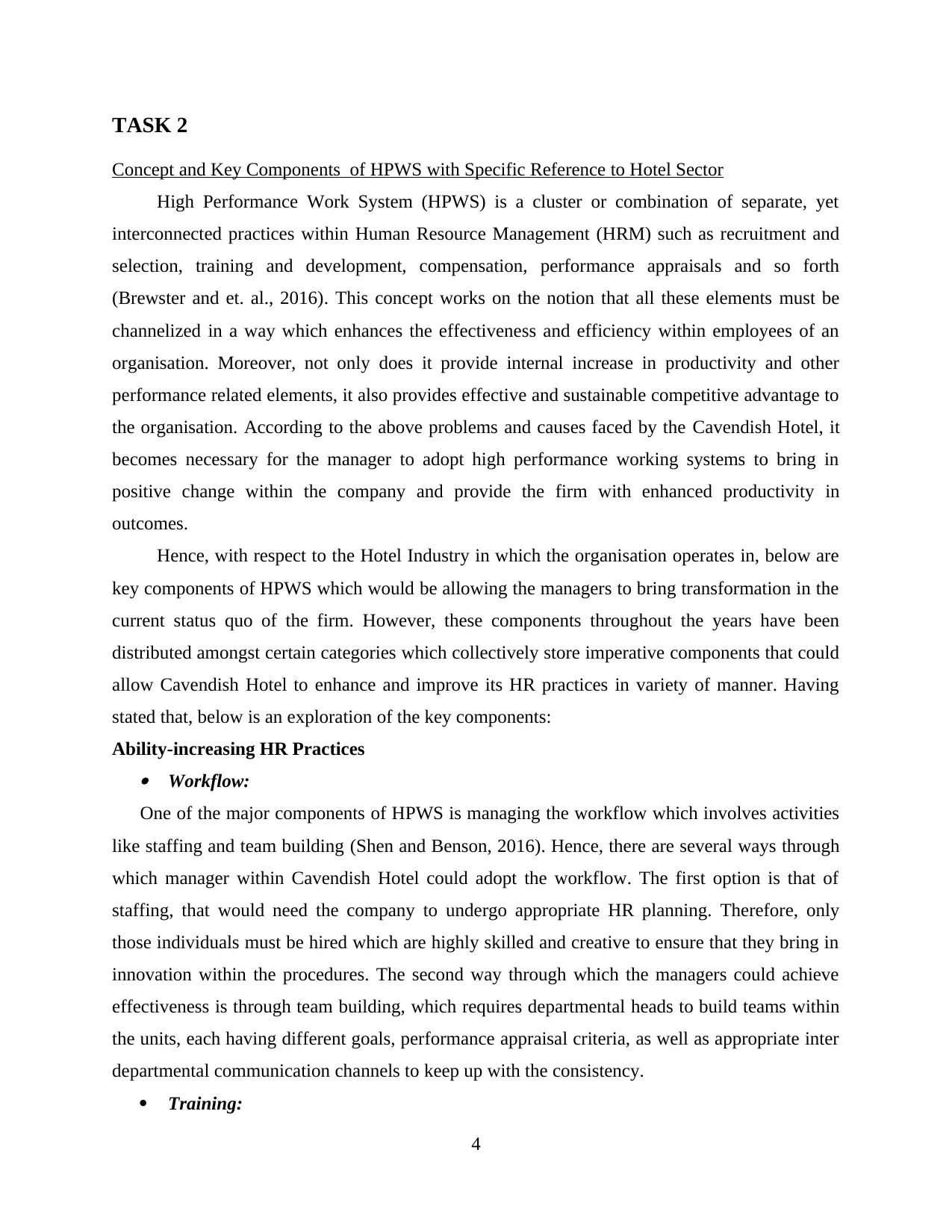
TASK 2
Concept and Key Components of HPWS with Specific Reference to Hotel Sector
High Performance Work System (HPWS) is a cluster or combination of separate, yet
interconnected practices within Human Resource Management (HRM) such as recruitment and
selection, training and development, compensation, performance appraisals and so forth
(Brewster and et. al., 2016). This concept works on the notion that all these elements must be
channelized in a way which enhances the effectiveness and efficiency within employees of an
organisation. Moreover, not only does it provide internal increase in productivity and other
performance related elements, it also provides effective and sustainable competitive advantage to
the organisation. According to the above problems and causes faced by the Cavendish Hotel, it
becomes necessary for the manager to adopt high performance working systems to bring in
positive change within the company and provide the firm with enhanced productivity in
outcomes.
Hence, with respect to the Hotel Industry in which the organisation operates in, below are
key components of HPWS which would be allowing the managers to bring transformation in the
current status quo of the firm. However, these components throughout the years have been
distributed amongst certain categories which collectively store imperative components that could
allow Cavendish Hotel to enhance and improve its HR practices in variety of manner. Having
stated that, below is an exploration of the key components:
Ability-increasing HR Practices Workflow:
One of the major components of HPWS is managing the workflow which involves activities
like staffing and team building (Shen and Benson, 2016). Hence, there are several ways through
which manager within Cavendish Hotel could adopt the workflow. The first option is that of
staffing, that would need the company to undergo appropriate HR planning. Therefore, only
those individuals must be hired which are highly skilled and creative to ensure that they bring in
innovation within the procedures. The second way through which the managers could achieve
effectiveness is through team building, which requires departmental heads to build teams within
the units, each having different goals, performance appraisal criteria, as well as appropriate inter
departmental communication channels to keep up with the consistency.
Training:
4
Concept and Key Components of HPWS with Specific Reference to Hotel Sector
High Performance Work System (HPWS) is a cluster or combination of separate, yet
interconnected practices within Human Resource Management (HRM) such as recruitment and
selection, training and development, compensation, performance appraisals and so forth
(Brewster and et. al., 2016). This concept works on the notion that all these elements must be
channelized in a way which enhances the effectiveness and efficiency within employees of an
organisation. Moreover, not only does it provide internal increase in productivity and other
performance related elements, it also provides effective and sustainable competitive advantage to
the organisation. According to the above problems and causes faced by the Cavendish Hotel, it
becomes necessary for the manager to adopt high performance working systems to bring in
positive change within the company and provide the firm with enhanced productivity in
outcomes.
Hence, with respect to the Hotel Industry in which the organisation operates in, below are
key components of HPWS which would be allowing the managers to bring transformation in the
current status quo of the firm. However, these components throughout the years have been
distributed amongst certain categories which collectively store imperative components that could
allow Cavendish Hotel to enhance and improve its HR practices in variety of manner. Having
stated that, below is an exploration of the key components:
Ability-increasing HR Practices Workflow:
One of the major components of HPWS is managing the workflow which involves activities
like staffing and team building (Shen and Benson, 2016). Hence, there are several ways through
which manager within Cavendish Hotel could adopt the workflow. The first option is that of
staffing, that would need the company to undergo appropriate HR planning. Therefore, only
those individuals must be hired which are highly skilled and creative to ensure that they bring in
innovation within the procedures. The second way through which the managers could achieve
effectiveness is through team building, which requires departmental heads to build teams within
the units, each having different goals, performance appraisal criteria, as well as appropriate inter
departmental communication channels to keep up with the consistency.
Training:
4
⊘ This is a preview!⊘
Do you want full access?
Subscribe today to unlock all pages.

Trusted by 1+ million students worldwide
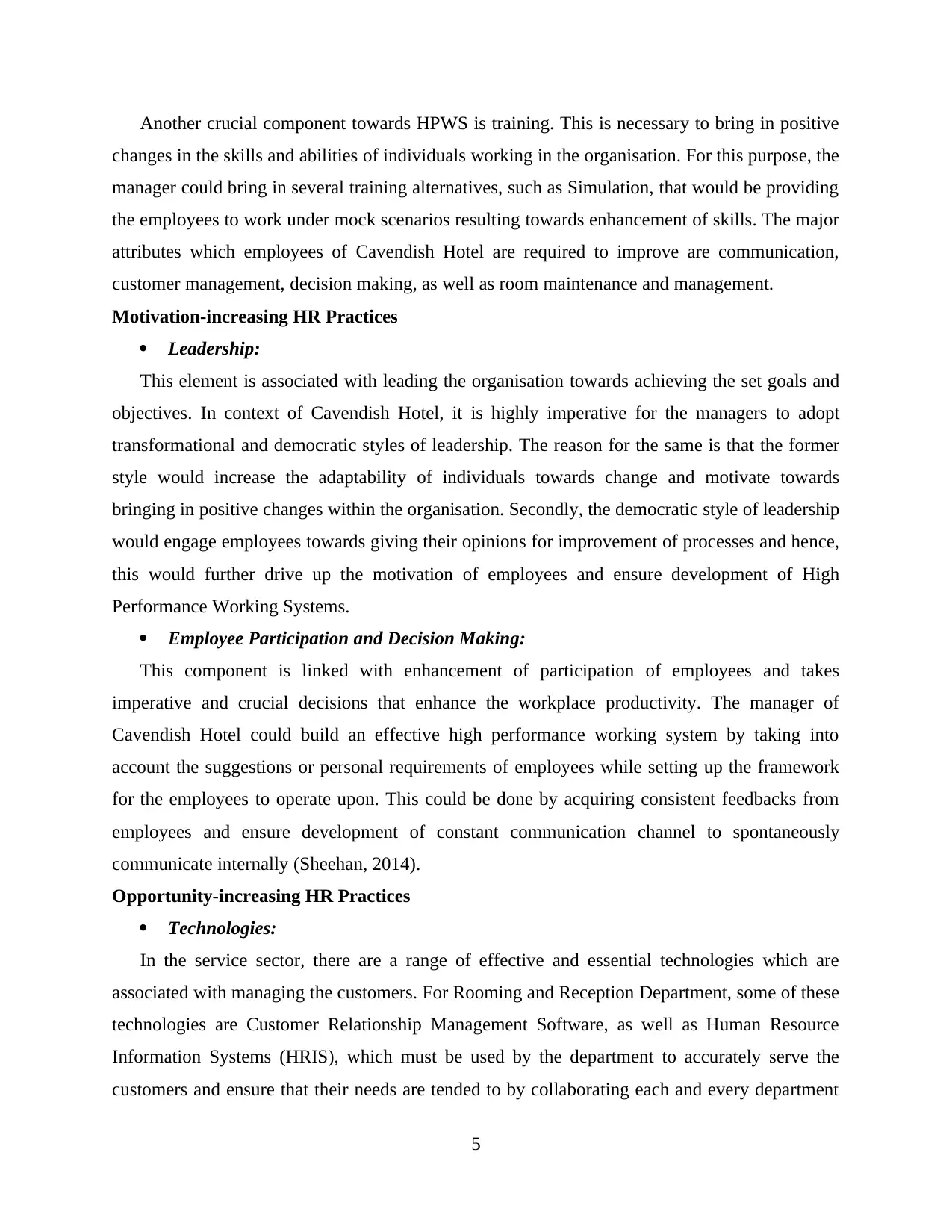
Another crucial component towards HPWS is training. This is necessary to bring in positive
changes in the skills and abilities of individuals working in the organisation. For this purpose, the
manager could bring in several training alternatives, such as Simulation, that would be providing
the employees to work under mock scenarios resulting towards enhancement of skills. The major
attributes which employees of Cavendish Hotel are required to improve are communication,
customer management, decision making, as well as room maintenance and management.
Motivation-increasing HR Practices
Leadership:
This element is associated with leading the organisation towards achieving the set goals and
objectives. In context of Cavendish Hotel, it is highly imperative for the managers to adopt
transformational and democratic styles of leadership. The reason for the same is that the former
style would increase the adaptability of individuals towards change and motivate towards
bringing in positive changes within the organisation. Secondly, the democratic style of leadership
would engage employees towards giving their opinions for improvement of processes and hence,
this would further drive up the motivation of employees and ensure development of High
Performance Working Systems.
Employee Participation and Decision Making:
This component is linked with enhancement of participation of employees and takes
imperative and crucial decisions that enhance the workplace productivity. The manager of
Cavendish Hotel could build an effective high performance working system by taking into
account the suggestions or personal requirements of employees while setting up the framework
for the employees to operate upon. This could be done by acquiring consistent feedbacks from
employees and ensure development of constant communication channel to spontaneously
communicate internally (Sheehan, 2014).
Opportunity-increasing HR Practices
Technologies:
In the service sector, there are a range of effective and essential technologies which are
associated with managing the customers. For Rooming and Reception Department, some of these
technologies are Customer Relationship Management Software, as well as Human Resource
Information Systems (HRIS), which must be used by the department to accurately serve the
customers and ensure that their needs are tended to by collaborating each and every department
5
changes in the skills and abilities of individuals working in the organisation. For this purpose, the
manager could bring in several training alternatives, such as Simulation, that would be providing
the employees to work under mock scenarios resulting towards enhancement of skills. The major
attributes which employees of Cavendish Hotel are required to improve are communication,
customer management, decision making, as well as room maintenance and management.
Motivation-increasing HR Practices
Leadership:
This element is associated with leading the organisation towards achieving the set goals and
objectives. In context of Cavendish Hotel, it is highly imperative for the managers to adopt
transformational and democratic styles of leadership. The reason for the same is that the former
style would increase the adaptability of individuals towards change and motivate towards
bringing in positive changes within the organisation. Secondly, the democratic style of leadership
would engage employees towards giving their opinions for improvement of processes and hence,
this would further drive up the motivation of employees and ensure development of High
Performance Working Systems.
Employee Participation and Decision Making:
This component is linked with enhancement of participation of employees and takes
imperative and crucial decisions that enhance the workplace productivity. The manager of
Cavendish Hotel could build an effective high performance working system by taking into
account the suggestions or personal requirements of employees while setting up the framework
for the employees to operate upon. This could be done by acquiring consistent feedbacks from
employees and ensure development of constant communication channel to spontaneously
communicate internally (Sheehan, 2014).
Opportunity-increasing HR Practices
Technologies:
In the service sector, there are a range of effective and essential technologies which are
associated with managing the customers. For Rooming and Reception Department, some of these
technologies are Customer Relationship Management Software, as well as Human Resource
Information Systems (HRIS), which must be used by the department to accurately serve the
customers and ensure that their needs are tended to by collaborating each and every department
5
Paraphrase This Document
Need a fresh take? Get an instant paraphrase of this document with our AI Paraphraser
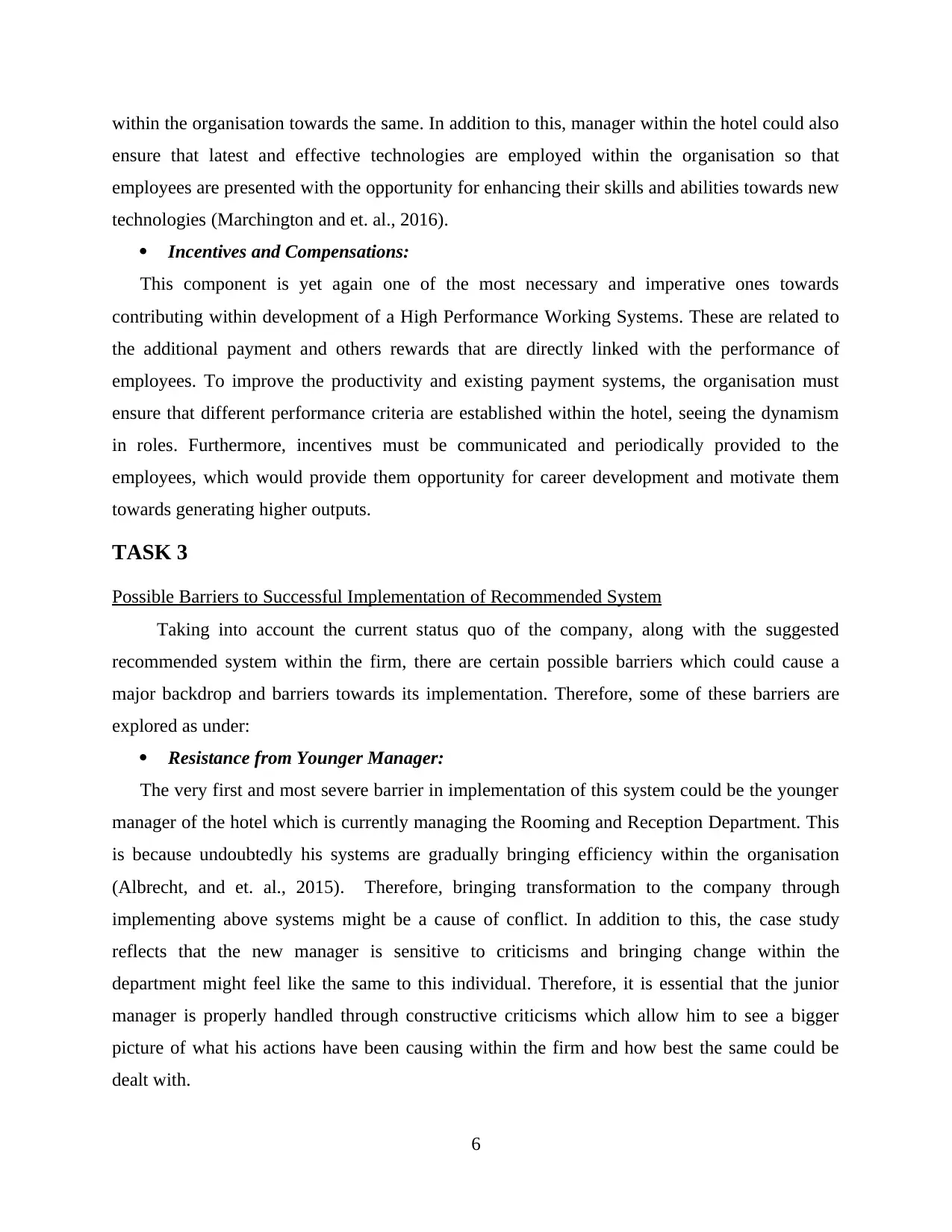
within the organisation towards the same. In addition to this, manager within the hotel could also
ensure that latest and effective technologies are employed within the organisation so that
employees are presented with the opportunity for enhancing their skills and abilities towards new
technologies (Marchington and et. al., 2016).
Incentives and Compensations:
This component is yet again one of the most necessary and imperative ones towards
contributing within development of a High Performance Working Systems. These are related to
the additional payment and others rewards that are directly linked with the performance of
employees. To improve the productivity and existing payment systems, the organisation must
ensure that different performance criteria are established within the hotel, seeing the dynamism
in roles. Furthermore, incentives must be communicated and periodically provided to the
employees, which would provide them opportunity for career development and motivate them
towards generating higher outputs.
TASK 3
Possible Barriers to Successful Implementation of Recommended System
Taking into account the current status quo of the company, along with the suggested
recommended system within the firm, there are certain possible barriers which could cause a
major backdrop and barriers towards its implementation. Therefore, some of these barriers are
explored as under:
Resistance from Younger Manager:
The very first and most severe barrier in implementation of this system could be the younger
manager of the hotel which is currently managing the Rooming and Reception Department. This
is because undoubtedly his systems are gradually bringing efficiency within the organisation
(Albrecht, and et. al., 2015). Therefore, bringing transformation to the company through
implementing above systems might be a cause of conflict. In addition to this, the case study
reflects that the new manager is sensitive to criticisms and bringing change within the
department might feel like the same to this individual. Therefore, it is essential that the junior
manager is properly handled through constructive criticisms which allow him to see a bigger
picture of what his actions have been causing within the firm and how best the same could be
dealt with.
6
ensure that latest and effective technologies are employed within the organisation so that
employees are presented with the opportunity for enhancing their skills and abilities towards new
technologies (Marchington and et. al., 2016).
Incentives and Compensations:
This component is yet again one of the most necessary and imperative ones towards
contributing within development of a High Performance Working Systems. These are related to
the additional payment and others rewards that are directly linked with the performance of
employees. To improve the productivity and existing payment systems, the organisation must
ensure that different performance criteria are established within the hotel, seeing the dynamism
in roles. Furthermore, incentives must be communicated and periodically provided to the
employees, which would provide them opportunity for career development and motivate them
towards generating higher outputs.
TASK 3
Possible Barriers to Successful Implementation of Recommended System
Taking into account the current status quo of the company, along with the suggested
recommended system within the firm, there are certain possible barriers which could cause a
major backdrop and barriers towards its implementation. Therefore, some of these barriers are
explored as under:
Resistance from Younger Manager:
The very first and most severe barrier in implementation of this system could be the younger
manager of the hotel which is currently managing the Rooming and Reception Department. This
is because undoubtedly his systems are gradually bringing efficiency within the organisation
(Albrecht, and et. al., 2015). Therefore, bringing transformation to the company through
implementing above systems might be a cause of conflict. In addition to this, the case study
reflects that the new manager is sensitive to criticisms and bringing change within the
department might feel like the same to this individual. Therefore, it is essential that the junior
manager is properly handled through constructive criticisms which allow him to see a bigger
picture of what his actions have been causing within the firm and how best the same could be
dealt with.
6

Financial Constraint:
Another barrier in regards to implementing the recommended system within the company is
financial constraint (Armstrong and Taylor, 2020). The above mentioned systems require a major
transformation to be performed in order to adopt resources and technologies which would help in
enhancing employee’s productivity. However, such heavy investment might not be in the best
interest for the company as it could lead the firm towards a heavy downfall economically. Hence,
to reduce the barrier, the firm could switch to sustainable alternatives which would be cheaper to
acquire and provide enhanced benefits to the hotel.
Time Management:
This barrier is associated with the time which would be taken to implement the above
mentioned systems. The hotel industry is the one which requires consistent performance of the
employees and the overall organisation, which might not be able to provide proper time for the
human resources to work with the new systems and get trained for the same. However, to reduce
this threat, Cavendish Hotel must prepare batches for the employees to switch to training
efficiently without being overwhelmed with the work (Van De Voorde and Beijer, 2015).
CONCLUSION
Thus, it is concluded from the report above that high performance working within human
resource management is very important to be adopted by organisations that aim at enhancing
their productivity and performance standards within the marketplace. It is essential that possible
causes of poor performance are identified to point out and determine the main areas of
improvement within the overall organisation. In addition to this, it is necessary to highlight the
concept and key components of High Performance Working Systems within the hotel sector to
identify the requirements of performance within businesses in the Hotel sector. Lastly, it is
essential that a range of barriers to successful implementation of recommended system are
identified to ensure that the same could be removed through intervening at early stage and
minimise the same to ensure high improvement in the existing working system of the company.
7
Another barrier in regards to implementing the recommended system within the company is
financial constraint (Armstrong and Taylor, 2020). The above mentioned systems require a major
transformation to be performed in order to adopt resources and technologies which would help in
enhancing employee’s productivity. However, such heavy investment might not be in the best
interest for the company as it could lead the firm towards a heavy downfall economically. Hence,
to reduce the barrier, the firm could switch to sustainable alternatives which would be cheaper to
acquire and provide enhanced benefits to the hotel.
Time Management:
This barrier is associated with the time which would be taken to implement the above
mentioned systems. The hotel industry is the one which requires consistent performance of the
employees and the overall organisation, which might not be able to provide proper time for the
human resources to work with the new systems and get trained for the same. However, to reduce
this threat, Cavendish Hotel must prepare batches for the employees to switch to training
efficiently without being overwhelmed with the work (Van De Voorde and Beijer, 2015).
CONCLUSION
Thus, it is concluded from the report above that high performance working within human
resource management is very important to be adopted by organisations that aim at enhancing
their productivity and performance standards within the marketplace. It is essential that possible
causes of poor performance are identified to point out and determine the main areas of
improvement within the overall organisation. In addition to this, it is necessary to highlight the
concept and key components of High Performance Working Systems within the hotel sector to
identify the requirements of performance within businesses in the Hotel sector. Lastly, it is
essential that a range of barriers to successful implementation of recommended system are
identified to ensure that the same could be removed through intervening at early stage and
minimise the same to ensure high improvement in the existing working system of the company.
7
⊘ This is a preview!⊘
Do you want full access?
Subscribe today to unlock all pages.

Trusted by 1+ million students worldwide
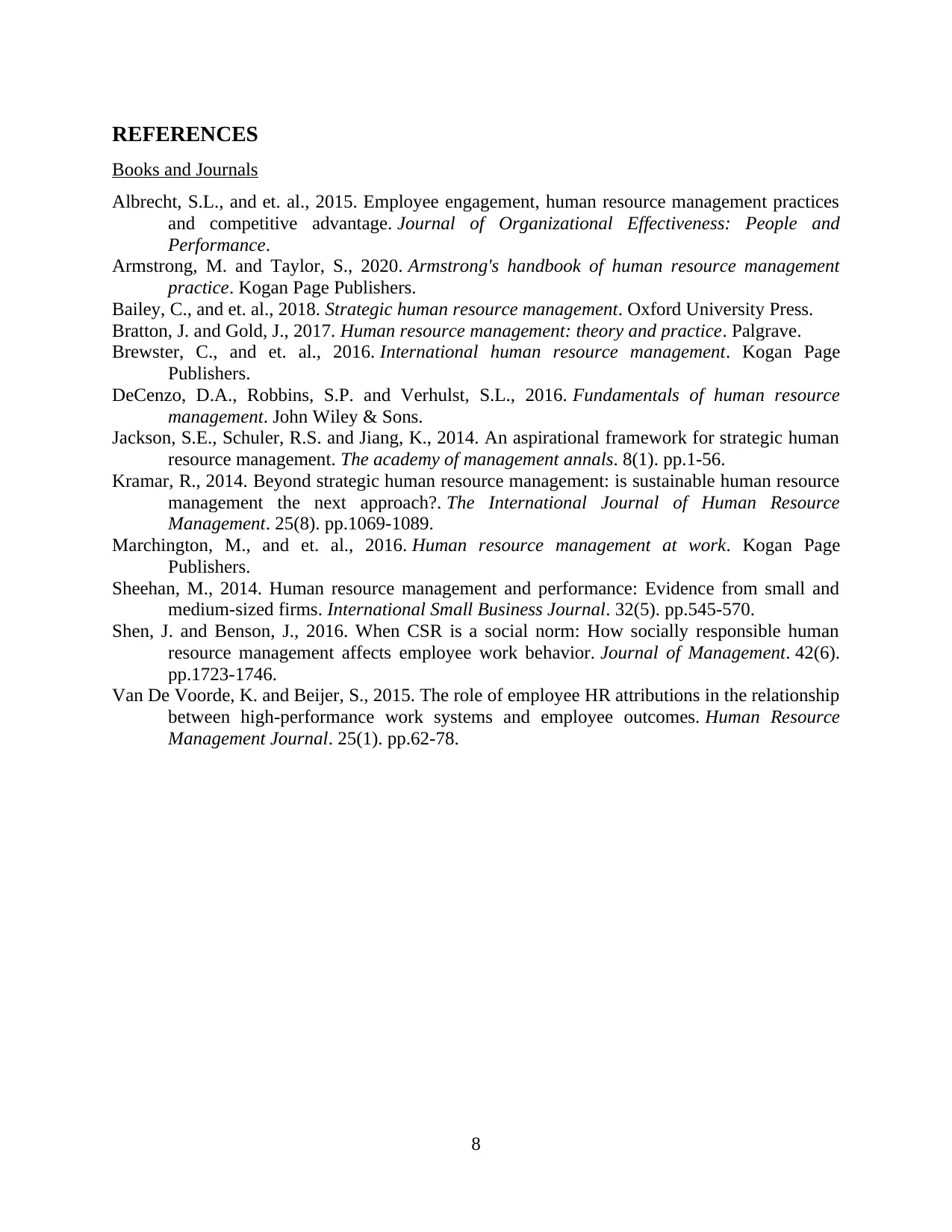
REFERENCES
Books and Journals
Albrecht, S.L., and et. al., 2015. Employee engagement, human resource management practices
and competitive advantage. Journal of Organizational Effectiveness: People and
Performance.
Armstrong, M. and Taylor, S., 2020. Armstrong's handbook of human resource management
practice. Kogan Page Publishers.
Bailey, C., and et. al., 2018. Strategic human resource management. Oxford University Press.
Bratton, J. and Gold, J., 2017. Human resource management: theory and practice. Palgrave.
Brewster, C., and et. al., 2016. International human resource management. Kogan Page
Publishers.
DeCenzo, D.A., Robbins, S.P. and Verhulst, S.L., 2016. Fundamentals of human resource
management. John Wiley & Sons.
Jackson, S.E., Schuler, R.S. and Jiang, K., 2014. An aspirational framework for strategic human
resource management. The academy of management annals. 8(1). pp.1-56.
Kramar, R., 2014. Beyond strategic human resource management: is sustainable human resource
management the next approach?. The International Journal of Human Resource
Management. 25(8). pp.1069-1089.
Marchington, M., and et. al., 2016. Human resource management at work. Kogan Page
Publishers.
Sheehan, M., 2014. Human resource management and performance: Evidence from small and
medium-sized firms. International Small Business Journal. 32(5). pp.545-570.
Shen, J. and Benson, J., 2016. When CSR is a social norm: How socially responsible human
resource management affects employee work behavior. Journal of Management. 42(6).
pp.1723-1746.
Van De Voorde, K. and Beijer, S., 2015. The role of employee HR attributions in the relationship
between high‐performance work systems and employee outcomes. Human Resource
Management Journal. 25(1). pp.62-78.
8
Books and Journals
Albrecht, S.L., and et. al., 2015. Employee engagement, human resource management practices
and competitive advantage. Journal of Organizational Effectiveness: People and
Performance.
Armstrong, M. and Taylor, S., 2020. Armstrong's handbook of human resource management
practice. Kogan Page Publishers.
Bailey, C., and et. al., 2018. Strategic human resource management. Oxford University Press.
Bratton, J. and Gold, J., 2017. Human resource management: theory and practice. Palgrave.
Brewster, C., and et. al., 2016. International human resource management. Kogan Page
Publishers.
DeCenzo, D.A., Robbins, S.P. and Verhulst, S.L., 2016. Fundamentals of human resource
management. John Wiley & Sons.
Jackson, S.E., Schuler, R.S. and Jiang, K., 2014. An aspirational framework for strategic human
resource management. The academy of management annals. 8(1). pp.1-56.
Kramar, R., 2014. Beyond strategic human resource management: is sustainable human resource
management the next approach?. The International Journal of Human Resource
Management. 25(8). pp.1069-1089.
Marchington, M., and et. al., 2016. Human resource management at work. Kogan Page
Publishers.
Sheehan, M., 2014. Human resource management and performance: Evidence from small and
medium-sized firms. International Small Business Journal. 32(5). pp.545-570.
Shen, J. and Benson, J., 2016. When CSR is a social norm: How socially responsible human
resource management affects employee work behavior. Journal of Management. 42(6).
pp.1723-1746.
Van De Voorde, K. and Beijer, S., 2015. The role of employee HR attributions in the relationship
between high‐performance work systems and employee outcomes. Human Resource
Management Journal. 25(1). pp.62-78.
8
1 out of 10
Related Documents
Your All-in-One AI-Powered Toolkit for Academic Success.
+13062052269
info@desklib.com
Available 24*7 on WhatsApp / Email
![[object Object]](/_next/static/media/star-bottom.7253800d.svg)
Unlock your academic potential
Copyright © 2020–2025 A2Z Services. All Rights Reserved. Developed and managed by ZUCOL.





